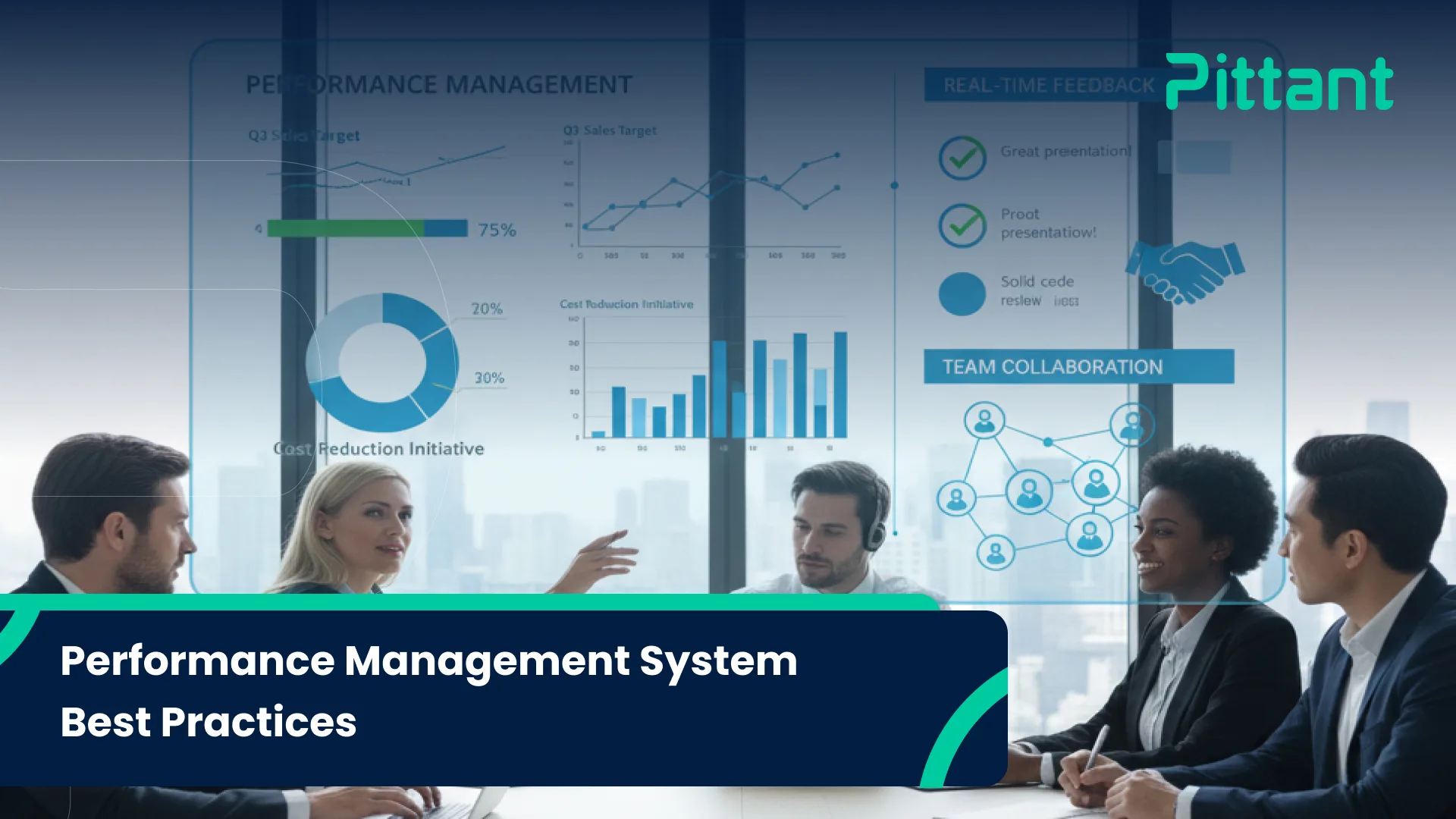What happens when companies only measure success once a year? They miss everything in between! Annual reviews quickly feel outdated, leaving employees frustrated and leaders scrambling for answers. This is where performance management system features make all the difference. Real time feedback, transparent goals, and actionable insights keep teams aligned, turning success into a continuous process instead of a once-a-year conversation.
The real shift comes when these conversations stay alive all year long. With continuous feedback, transparent goal tracking, and data that leaders can actually use, modern performance management systems are changing what was once the industry norm. Across Saudi Arabia, annual reviews are being left in the archives as Vision 2030 pushes businesses toward smarter, faster, and more digital-first ways of working. Businesses that once struggled to keep their employees engaged are now finding energy, direction, and clarity in ways the old systems never offered.
In this blog post, we will cover the key features of performance management systems, how they benefit businesses like yours, and share tips on how you can choose the right one for your organization.
What is a Performance Management System?
Delayed feedback does little to improve performance or motivation. And if employees don’t know how they’re doing until it’s too late, they can’t course-correct or grow. Many organizations that stuck to this old-school approach found themselves losing talent, missing goals, and struggling to align teams.
Modern systems changed that. At its core, a performance management system (PMS) is a structured way to plan, monitor, and review employee performance. An effective performance management system works as an ongoing cycle of goal setting, feedback, and development. It changes the way how managers and employees communicate about performance.
Organizations are shifting toward modern PMS features because the workforce has changed. Employees expect more transparency, recognition, and growth opportunities. Businesses, on the other hand, need visibility into performance at both individual and team levels to stay competitive. A modern PMS bridges those needs, going beyond paperwork to become a true business growth driver.
In the fast-growing sectors of healthcare, retail, and construction, companies in KSA are turning to an effective performance management system to keep a young and ambitious workforce moving in the right direction.
Key Features of Performance Management Systems
You need to understand the key features of performance management system tools, before deciding on which software you should bring into your organization. For Saudi businesses, these performance management system features are becoming must-haves to manage teams that often combine local talent with global expertise.
Goal Setting & Alignment
The strongest PMS features start with goal clarity. Systems today let managers and employees create SMART goals that connect directly to company objectives. Think cascading goals where the CEO’s vision trickles down to every team member.
When everyone sees how their daily work ties into bigger outcomes, the performance management process stops feeling abstract and starts feeling personal. Cascading goals also align businesses with Vision 2030, making sure every milestone supports the bigger national picture.
Continuous Feedback & Coaching
Why wait until December to tell someone they’ve been doing something wrong since March? Continuous feedback allows managers to share insights in real time, while coaching features provide employees with guidance when it actually matters.
Saudi companies with multiple branches are finding real-time feedback invaluable, as it keeps performance consistent whether teams sit in Riyadh, Jeddah, or Dammam. This not only improves day-to-day performance but also makes staff performance evaluation a shared, ongoing conversation rather than a dreaded annual event.
Performance Reviews & Appraisals
Automated review cycles, flexible templates, and customizable forms make it easier to conduct meaningful evaluations without drowning in paperwork. Employees appreciate that their employee performance appraisal reflects current contributions, not outdated recollections. Managers, meanwhile, save time while capturing a more accurate picture of performance.
Analytics & Reporting
Data no longer sits in dusty spreadsheets. Analytics are now helping businesses track Saudization goals while planning smarter for the future.
Today’s PMS tools offer dashboards and predictive insights that reveal performance trends, identify skill gaps, and even flag potential retention risks. Leaders finally get the context they need to make smart calls about promotions, training, and team structures.
Integration with HR & Business Tools
A system that can’t connect with your HRIS, payroll, or collaboration platforms is more hassle than help. That’s why integration is one of the most valuable PMS features.
Modern systems deliver smoother workflows, better accuracy, and a single source of truth by connecting with other platforms. This is also where choosing effective performance management software pays off. You get efficiency without juggling multiple tools.
Benefits of PMS Features for Businesses
Understanding features of performance management system software is one thing. Seeing how they impact your business is entirely another. When implemented well, performance management tools and features offer benefits across engagement, decision-making, and productivity. These benefits are quite the game changers for companies competing to attract and retain talent in KSA, one of the fastest growing markets in the world right now.
Improved Employee Engagement
Employees thrive when they know what’s expected and get recognized for progress. Modern PMS tools give them visibility into goals and regular feedback, which builds motivation and loyalty.
Better Decision-Making
Data takes the guesswork out of promotions, training, and workforce planning. Leaders can make fairer, faster calls when they have visibility into performance metrics. Interlinking this with evaluating job performance, businesses move from assumptions to actionable insights. PMS insights also help leaders align promotions and hiring with Saudization targets, hitting both business and national goals in one move.
Increased Productivity & Alignment
When goals cascade down and everyone’s progress is tracked in one place, teams move in the same direction. It reduces wasted effort and brings sharper focus to daily work.
How You Can Effectively Implement Performance Management System Features
To implement performance management system features effectively, start by identifying what matters most to your organization. Do you need stronger analytics? Or maybe better feedback loops? Choose a solution that fits your priorities.
When you are running a Saudi business, picking the right PMS also includes choosing tools with Arabic support, local payroll integration, and compliance features designed for the KSA market.
Train your managers to use the system properly. A tool is only as good as the people using it. Then, set up clear processes for goal setting, reviews, and feedback so employees know what to expect. Finally, collect feedback on the tool itself. The best systems scale with the business, not against it.
Modern PMS vs. Traditional Systems
Modern PMS is quite different from traditional systems, as it analyzed what didn’t work with appraisals and slow loop of feedback. It implemented the findings to come up with solutions that benefit the workforce. From outdated annual reviews, we have now come all the way to continuous improvement.
Modern PMS
Today’s systems are proactive. They center on agility, feedback, and data insights. Instead of waiting for problems to surface, leaders can spot trends and intervene early. As a result, you get a system that drives growth instead of dragging it down.
This shift is playing out clearly in Saudi Arabia, where forward-thinking companies are ditching rigid reviews for systems built on continuous feedback and fast decision-making.
Traditional Systems
Old models revolved around compliance. Annual appraisals were more of a checkbox exercise. Feedback was often vague or even outdated at times, resulting in employees dreading them and managers treating them as chores.
Industries That Benefit the Most from PMS Features
While every business can gain value, some industries feel the impact more deeply. The demand is significantly increasing in sectors spotlighted by Vision 2030 (healthcare, education, and technology) where developing people is as important as growing profits
IT & Tech Companies
Fast-moving environments demand goal flexibility and innovation tracking. PMS tools keep performance aligned with shifting priorities.
Healthcare & Education
With structured staff performance evaluation needs and compliance requirements, these sectors rely on PMS to balance accountability with growth.
Retail & Manufacturing
Large workforces need clear performance tracking and productivity metrics. PMS systems give managers the visibility to keep operations smooth.
Challenges & How You Can Overcome Those
Every tool comes with hurdles. The solution is knowing them upfront and tackling them head-on.
Resistance to Change
Employees may feel uneasy about new systems. Solve this with strong training programs and visible leadership buy-in. In Saudi Arabia, there’s also the balancing act of blending global best practices with local cultural norms around feedback, which makes training essential.
Data Overload
Dashboards can overwhelm managers if every metric gets tracked. Focus on meaningful KPIs instead of vanity numbers.
Ensuring Fair Evaluations
Bias can creep into evaluations. Use 360-degree reviews and transparent metrics to keep fairness front and center.
Final Thoughts: Making PMS Features a Growth Driver
The right PMS can transform how your teams perform. So, choose a system that fits your business needs and watch performance shift from routine check-ins to a genuine driver of success.
Modern performance management system features not only make HR’s life easier, these also fuel employee engagement, sharpen your decision making, and align your business toward growth. Adapting modern PMS features is also the edge that keeps businesses competitive in KSA’s market where talent, compliance, and innovation move fast. Get in touch with us to integrate Pittant with your organization.
FAQs
What are the key features of a performance management system?
These include goal alignment, continuous feedback, flexible reviews, analytics, and integration with HR tools.
How do PMS features improve employee engagement?
They give employees clarity on expectations and provide timely recognition, boosting motivation and retention.
Are PMS features different from performance appraisal tools?
Yes. Appraisal tools focus on past performance, while PMS tools support continuous growth, feedback, and alignment.
What industries benefit most from performance management tools and features?
IT, healthcare, education, retail, and manufacturing see the biggest impact, though all industries can benefit.



